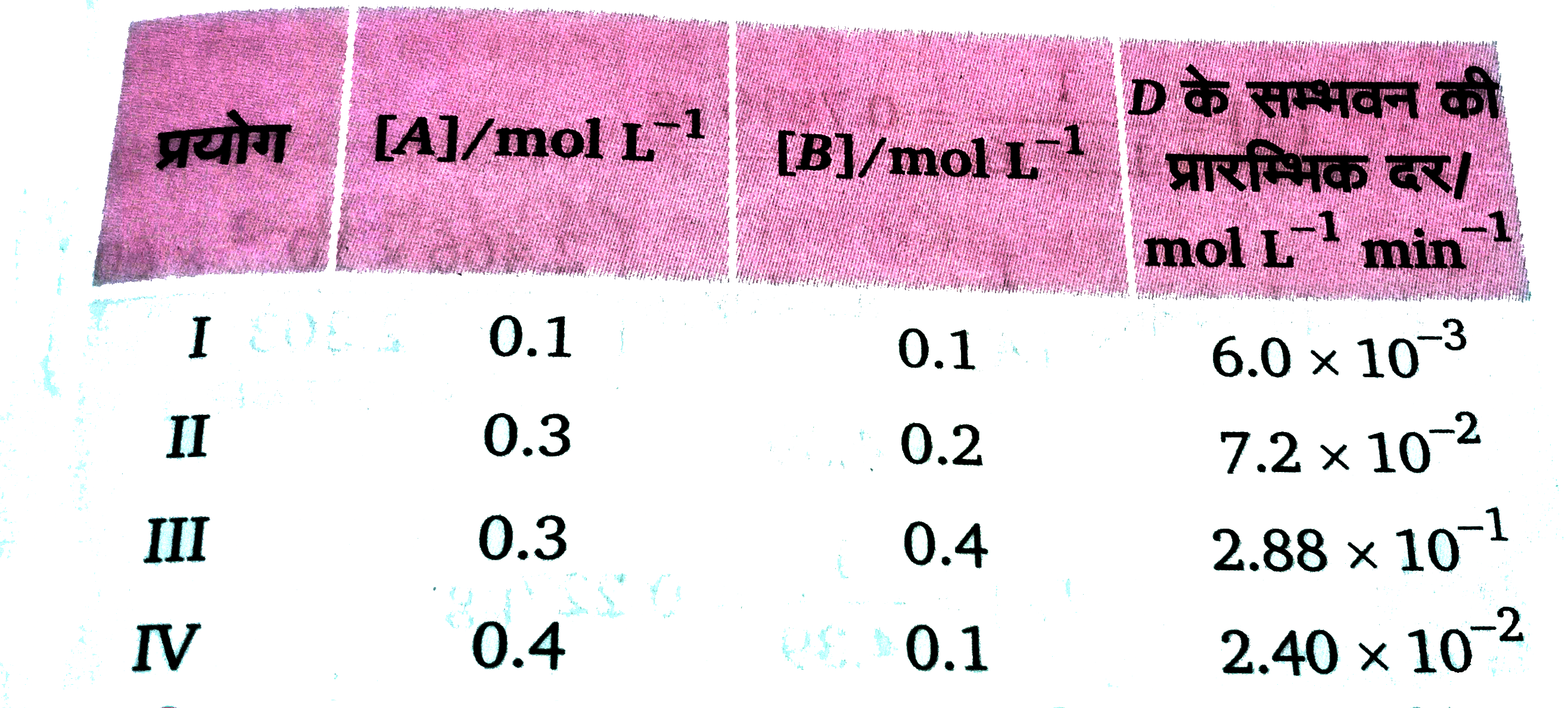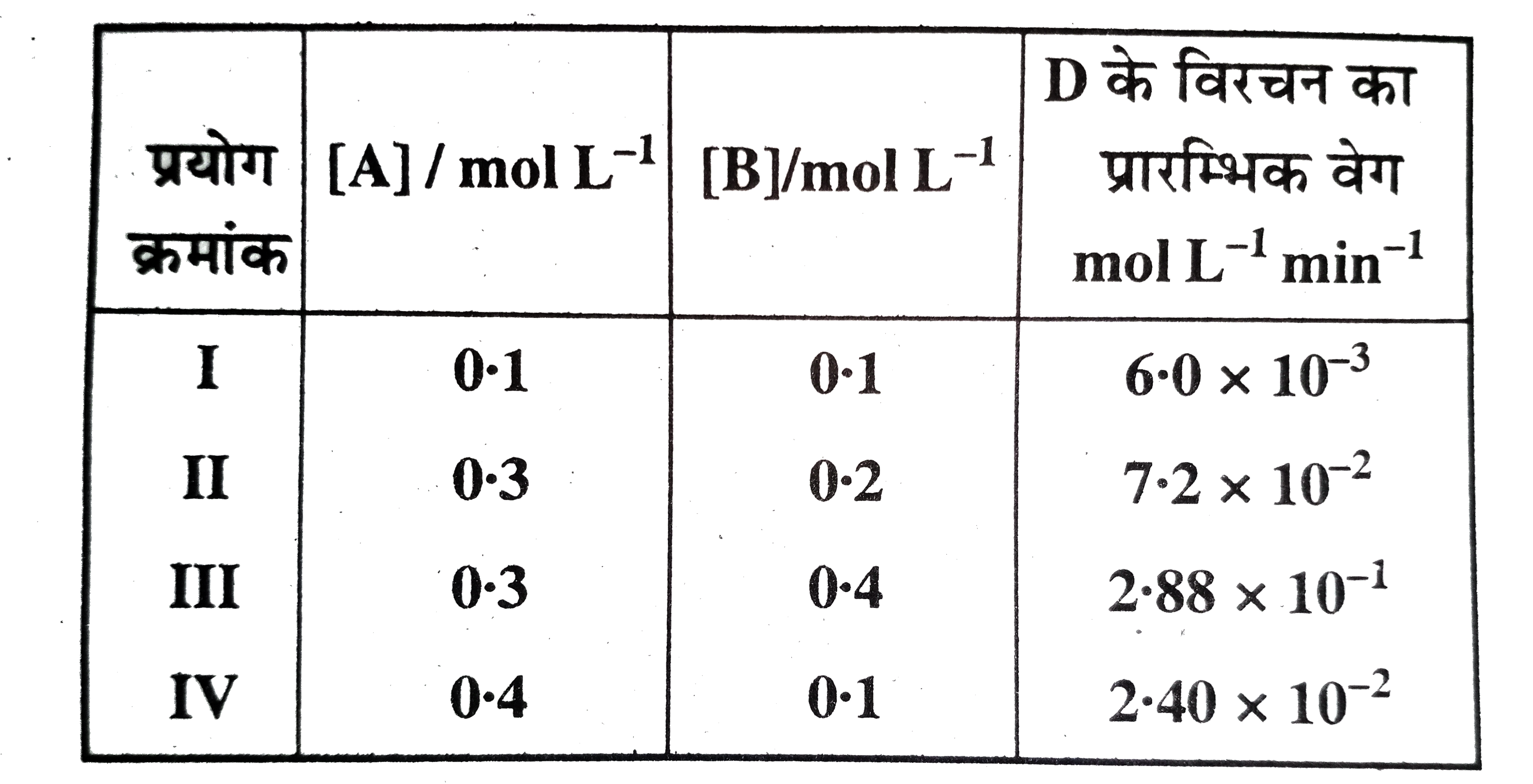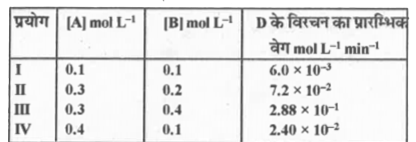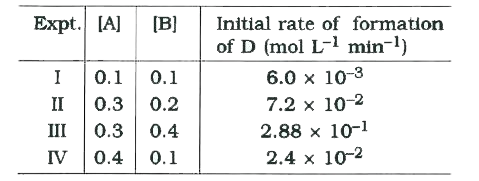The following results have been obtained during the kinetic studies of the reaction,
2A+B→C+D.

Determine the rate law and the rate constant for the reaction. Solution in Odia
Rate law may be expressed as
Rate =k[A]x[B]y
(Rate)1=6.0×10−3=k(0.1)x(0.1)y ...(i)
(Rate)2=7.2×10−2=k(0.3)x(0.2)y ...(ii)
(Rate)4=2.88×10−1=k(0.3)x=(0.4)y ...(iii)
(Rate)4=2.40×10−2=k(0.4)x(0.1)y ...(iv)
(Rate)1(Rate)4=6.0×10−32.40×10−2=k(0.1)x(0.1)yk(0.4)x(0.1)y
or 14=(0.1)x(0.4)x=(14)x ∴x=1
(Rate)2(Rate)3=7.2×10−22.88×10−1=k(0.3)x(0.2)yk(0.3)x(0.4)y
or 14(0.2)y(0.4)y=(12)y ∴y=2
Now, rate law expression is given by
Rate =k[A][B]2
Topper's Solved these Questions
- CHEMICAL KINETICSBOOK - ARIHANT PUBLICATIONCHAPTER - CHEMICAL KINETICSEXERCISE - QUESTIONS FOR PRACTICE (Part I Rate of Chemical Reaction, Differential Rate Law and Rate Constant) Multiple Choice Type questions
2 Videos
- CHEMICAL KINETICSBOOK - ARIHANT PUBLICATIONCHAPTER - CHEMICAL KINETICSEXERCISE - QUESTIONS FOR PRACTICE (Part I Rate of Chemical Reaction, Differential Rate Law and Rate Constant) Very Short Answer Type Questions
5 Videos
- CARBOXYLIC ACIDS BOOK - ARIHANT PUBLICATIONCHAPTER - CARBOXYLIC ACIDS EXERCISE - CHAPTER PRACTICE (LONG ANSWER TYPE QUESTIONS)
3 Videos
- CHEMISTRY IN EVERYDAY LIFE BOOK - ARIHANT PUBLICATIONCHAPTER - CHEMISTRY IN EVERYDAY LIFE EXERCISE - CHAPTER PRACTICE (LONG ANSWER TYPE QUESTIONS)
2 Videos
Similar Questions
Rate of a reaction can be defined as
View SolutionHow is the rate law different from law of mass action?
View SolutionConvert
(a) the benzoic acid to benzaldehyde
(b) the propanone to propane
View Solution(a) With the help of an example explain how do tranquilizers act as antidepressants?
View SolutionDuring the kinetic study of the reaction, 2A+B→C+D. Following results were obtained.

Based on the above data which one of the following is correct?
View SolutionThe following rate data were obtained at 303 K for the following reaction:
2A+B→C+D

What is the rate law? What is the order with respect to each rectant and the overall order? What are the units of the rate constant?
View SolutionConsider the reaction 2A + B to C + D Following results was obtained in experiments designed to study the rate of reaction" a) Write the rate law for the reaction b) Calculate the value of rate constant for the reactio. c) Which of the following possible reaction mechanisms is consistent with the rate law found in (a) ? I. A + B to C + E (slow) A + E to D (fast) IIgt B to C+E (slow) A + E to F (fast) A + F to D (fast)
View SolutionThe following initial rate data were obtained at 300K for the reactions: 2A + B to C +D Deducethe rate law.
View SolutionDuring the kinetic study of the reaction, 2A+BtoC+D , following results were obtained Order of the reaction is
View Solutionकिसी अभिक्रिया कि बलगतिकी के अध्ययन से निम्न परिणाम प्राप्त हुए-

अभिक्रिया के लिए वेग नियम तथा सिथरांक ज्ञात कीजिये।
View Solution2A+B→C+D अभिक्रिया की बलगतिकी अध्ययन करने पर निम्नलिखित परिणाम प्राप्त हुए। अभिक्रिया के लिए वेग नियम तथा वेग स्थिरांक ज्ञात कीजिए।

View SolutionThe following results have been obtained during the kinetic studies of reaction : The rate law is
View SolutionDuring the kinetic study of the reaction, 2A+Brarr C+D , following results were obtained Based on the above data which one of the following is correct?
View Solution2A+B→C+Dअतः अभिक्रिया की बगलतिकी अध्यन करने पर निम्नलिखित परिणाम प्राप्त हुए। अभिक्रिया के लिए नियम तथा वेग । स्थिरांकज्ञात कीजिए।

View SolutionThe following results have been obtained during the kinetic studies of the reaction:
P+2Q→R+2S

Determine the rate law expression for the reaction.
View SolutionThe following rate date were obtained at 313 K for the reaction :
2A+2B→C+D

The rate law for the reaction is :
View Solution
